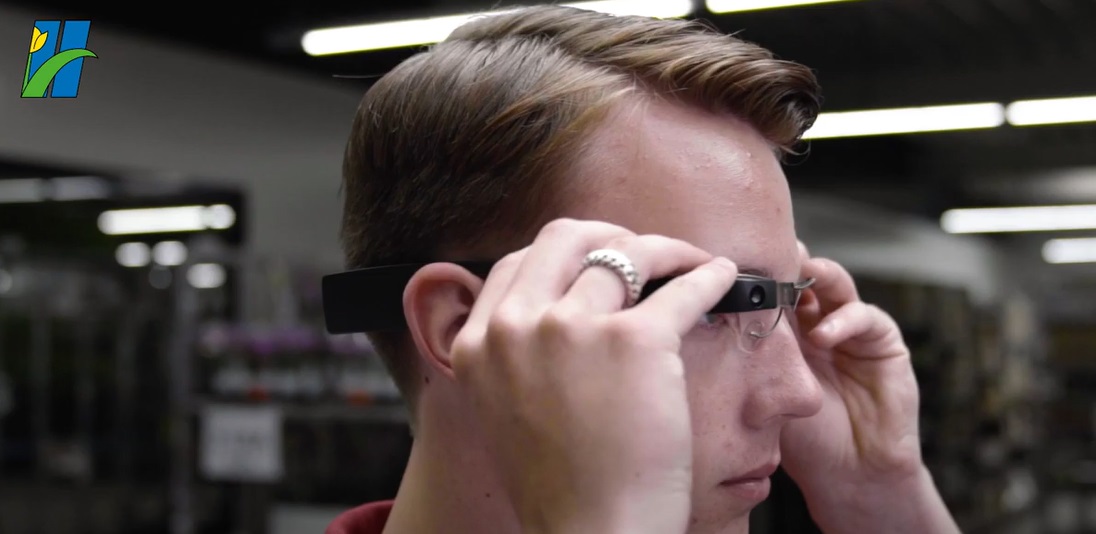INNOVATIVE APPROACH TO ORDER-PICKING
Pick-by-Vision
One of our core values is Innovation. We are open to new ideas, developments and changes. This benefits the organisation and our employees, and also benefits you as a florist. Because innovation improves the operational processes, which means that you receive your product as quickly as possible and without errors. Hence we started using Pick-by-Vision this year. We are the first and only business in the Netherlands to be using this technology, of which we are very proud! We would like to tell you more about this innovative approach to order-picking, and we talk to the developer.
What is Pick-by-Vision?
Pick-by-Vision is a new approach to order-picking using smart glasses. The aim is to ensure that the order-picking process is quick and error-free. A simple touch on the glasses displays a picking order. A start screen shows what the volume of the order is and how many carts you will need. You can then start order-picking. The glasses show the route to walk and display what product you need to collect and what quantity.
The story behind Pick-by-Vision
The second generation is now in charge at our family business. The nice thing about Pick-by-Vision is that it has come from the third generation: the developer behind Pick-by-Vision is Lars Heemskerk, Bert Heemskerk’s son. Lars is an ICT-er through and through, and learned entrepreneurship at his father’s knee. He started his own business building websites at the age of just 14. His dream has always been to develop a product or service with which he could improve operational processes. And Pick-by-Vision very much meets that brief! We talked to Lars about the development and implementation of Pick-by-Vision at Heemskerk Flowers.
Could you tell us something about how Pick-by-Vision started?
‘Google launched Google Glass in 2013. That gave me the idea of developing these glasses into glasses that you can use for order-picking. A number of tests showed that this version was not good enough in practical terms to allow that development. For example, the screen was not bright enough. These glasses were more consumer-oriented. But in 2019 Google launched a second model, the ‘Enterprise Edition’. And these glasses were suitable, so I got to work with them. They turned out not to be on public sale for the European market, which means that you can only get hold of these glasses through a partnership with Google. Through connections I was able to become one of Google Glass’s twenty-five global partners, and the first in the Netherlands. After a six month development period, we started the first test phase in mid-June of this year. We achieved some good results during this test phase. We then rapidly scaled up so that all the order pickers in the plant department now pick orders using Pick-by-Vision.’
Could you list some of those good results?
‘Certainly. In this initial test phase we started with two devices. That enabled us to make a good comparison between the results of employees with Google Glass glasses and employees without these glasses. We found that the error margin for the glasses users fell from 3.5% to 1.5%. The error margin remained unchanged for the order pickers without glasses. So this was already a very clear result. And because we incorporated two walking directions in Pick-by-Vision, the speed also improved by 55%. So as an order picker you never walk a stretch without order-picking.’

What do you think are the most important benefits of order-picking with Pick-by-Vision?
‘Because the route we walk is planned and there are two walking directions, picking is carried out more quickly. It is also much less prone to error. That’s because picking is done by location and product photo, not by product name. If someone still picks up the wrong item, the glasses will display an error message. In addition to speed and reduced error margin, I also think it’s a big advantage that new employees can get to work very quickly with Pick-by-Vision. This shortens the onboarding process and new employees achieve the required standard more quickly.’
What else is in the pipeline?
‘We started in the plant department. Within few weeks we want to expand that to the flower department. Another option that we are working on is a check of the product quality. The glasses can photograph the products using a camera, whereby we can monitor and safeguard quality. Another idea for the future is that we expand the process from just picking the plants to order-picking and immediate filling the shipping carts. That removes a step from the process, enabling us to deal with orders even more quickly.’

